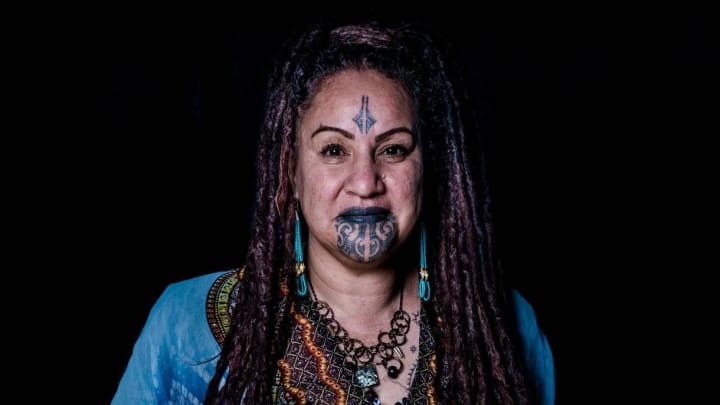Invisible No Longer
The moko kauae is the spiritual Māori tattoo which almost went extinct. Yet today, there is a resurgence in the artform as Māori women refuse to remain invisible any longer.

In the 1800’s, when New Zealand was colonised, the ancient and sacred female tattooing practice of moko kauae began to fade away. Its very existence was placed under threat alongside the spiritual culture and identity of Māori. Yet, what was initially thought to be lost by the devastating impact of colonisation, has now begun to blossom once again; meaning that a whole new generation of Māori women can wear their identity with pride.
The deeply personal and emotive artform of moko kauae stems beyond the aesthetic and fashionable motives usually associated with tattoos, for the moko kauae is the true identity of Māori women. The tattoo is considered a physical manifestation of who they are. It is believed that every Māori woman wears a moko on the inside, close to her heart. The tattoo artist simply brings the moko to the surface.

The facial and body tattooing of Māori culture is known as Tā moko. An ancient art form, its origins descend from West Polynesia. Each moko is unique to the wearer and the intricate designs were chiselled onto the skin using an uni – the ink is then smudged into the carved lines.
Tā moko represents the wearer’s family heritage and social status, and is believed to signify their visit to the spiritual realm where they encounter their tupuna (ancestors) and return as a new person. The moko kauae marks a similar rite of passage for Māori women, though from girl to adulthood.Whilst today the culture is resurging, from 1840, with the influx of English settlers, the Māori were forced from their lands and assimilation began. Laws were passed under colonialism enforcing the ban of tohunga – or Māori experts – and children were caned for speaking Māori at school. By the time of the 1970s, the moko was all but non-existent. One element which impacted the reputation of the moko was the negative connotations surrounding face tattoos. Adopted by disaffected urban Māori, the became associated with gangs and crimes.

In the 1980s, attitudes began to change. With a significant push to revive Māori language and culture, Tā moko has successfully began to navigate itself back into modern life.
A new and active generation of Māori women are carrying the artform forward, teaching younger generations the importance of moko, as well as the deeply held beliefs associated with the tattoo. Artist Pip Hartley owns a tattoo studio, Karanga Ink, in Auckland and is proudly promoting the moko process. For her, it is the intensely personal process of the moko on which she focuses on. “I prefer to draw straight onto the person, because it's an exchange of wairua, or energy. It's working with the contours of their body and translating their story, and for a lot of people it's a transformative experience. Every time they see it, it's a reminder of what they've achieved, and that their tupuna have their back.”
(VIDEO: Pip Hartley talks about the process of the moko kauae)
Although it is a spiritual experience, the moko kauae also demonstrates the wearer’s commitment to the culture of their ancestors. It is, in respect, a vow to uphold the Māori way of life. But there is no time set for a woman to receive her moko, instead it is an internal calling.
The benefits of the moko kauae far outweigh any downsides. For many, it is an acceptance of who they are, and a statement on which culture, they as women, belong to. Jude Hoani received her moko three years ago and for her it was about defining who she is. Describing the process of getting the tattoo she stated it wasn’t painful, but peaceful, if not a little uncomfortable. “It was more uncomfortable. A quarter of orange in the mouth to bite on, and we were done.”
For many Māori women, the moko stops them from being invisible; it speaks of healing, reflection, empowerment and identity. It enables their culture to continue, and through the physical manifestation of the moko kauae, it is the end of one journey, and the beginning of a new one.

There has been some disagreement over whether the moko is a rite of passage to be earned, or a birth-right destined for all Māori women. The latter seems to be the general consensus amongst modern-day Māori tribes, and it is hard not to agree. The spiritual printing of Tā moko was an artform which was normal, and became not normal. Barriers were used to block the tattoo and finally they are being torn down.
For Māori culture, the moko kauae is the external spiritual acceptance of the internal connection to the ancestors whose hopes, dreams and presence are much more than defined by the intricate design of a tattoo. It is their identity etched in the hand of their loved ones, whose traditions and teachings are finally being revived by the generation of Māori women who are refusing to remain invisible any longer.
You can learn more about the moko kauae and Tā moko through the link below:
About the Creator
Jonathan Reed
Our blog covers everything from entertainment, Movies, Politics, The Royal Family and so much more!!
Let's get ready to RUMBLE!
Visit us at our website:







Comments
There are no comments for this story
Be the first to respond and start the conversation.